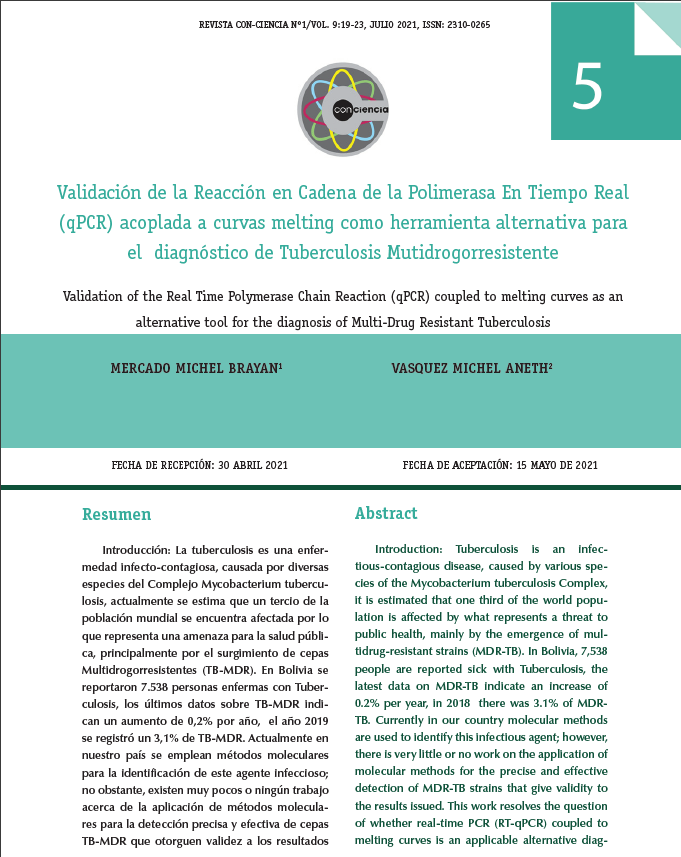VALIDACIÓN DE LA REACCIÓN EN CADENA DE LA POLIMERASA EN TIEMPO REAL (qPCR) ACOPLADA A CURVAS MELTING COMO HERRAMIENTA ALTERNATIVA PARA EL DIAGNÓSTICO DE TUBERCULOSIS MUTIDROGORRESISTENTE
VALIDATION OF REAL-TIME POLYMERASE CHAIN REACTION (qPCR) COUPLED TO MELTING CURVES AS AN ALTERNATIVE TOOL FOR THE DIAGNOSIS OF MUTI-DRUG RESISTANT TUBERCULOSIS
DOI:
https://doi.org/10.53287/vbgg9961cx41zPalabras clave:
Tuberculosis, tuberculosis multidrogorresistentes, PCR en tiempo real acoplado a curvas melting, validaciónResumen
Introducción.-
La tuberculosis es una enfermedad infecto-contagiosa, causada por diversas especies del Complejo Mycobacterium tuberculosis, actualmente se estima que un tercio de la población mundial se encuentra afectada por lo que representa una amenaza para la salud pública, principalmente por el surgimiento de cepas Multidrogorresistentes (TB-MDR). En Bolivia se reportaron 7.538 personas enfermas con Tuberculosis, los últimos datos sobre TB-MDR indican un aumento de 0,2% por año, el año 2019 se registró un 3,1% de TB-MDR. Actualmente en nuestro país se emplean métodos moleculares para la identificación de este agente infeccioso; no obstante, existen muy pocos o ningún trabajo acerca de la aplicación de métodos moleculares para la detección precisa y efectiva de cepas TB-MDR que otorguen validez a los resultados emitidos. Este trabajo resuelve el cuestionamiento de, si la PCR en tiempo real (RT-qPCR) acoplada a curvas melting es una herramienta de diagnóstico alternativo aplicable, para la identificación de Tuberculosis Multidrogorresistente.
Materiales y Métodos.-
Se trabajó con 74 cepas de Mycobaterium tuberculosis fenotípicamente identificadas por cultivo (método de las proporciones, Canetti Rist) como gold standar. El material genético para las pruebas moleculares se obtuvo por el método de columnas, se utilizaron dos controles primarios para la determinación de resistencia a los fármacos Isoniacida y Rifampicina, tanto los controles como las muestras se procesaron por RT-qPCR acoplada a curvas melting, mediante cambios de temperatura de disociación.
Resultados.- Loa parámetros de test diagnóstico de la prueba demostraron sensibilidad: 67.4%, especificidad: 83.3%, Exactitud: 73.97%, VPP: 85.3%, VPN: 64.1% para Isoniacida. Mientras que para Rifampicina: Sensibilidad: 97%, especificidad: 20%, exactitud: 58.9%, VPP: 55.4% y VPN: 87.5%.
Conclusión.-El método evaluado para la determinación de resistencia a Isoniacida presenta un equilibrio entre sensibilidad y especificidad, por lo que representa una alternativa diagnóstica confiable, mientras que para resistencia a Rifampicina presenta una alta sensibilidad que es muy útil para países endémicos como el nuestro.
ABSTRACT
VALIDATION OF REAL-TIME POLYMERASE CHAIN REACTION (qPCR) COUPLED TO MELTING CURVES AS AN ALTERNATIVE TOOL FOR THE DIAGNOSIS OF MUTI-DRUG RESISTANT TUBERCULOSIS
Introduction.-
Tuberculosis is an infectious-contagious disease, caused by various species of the Mycobacterium tuberculosis Complex, it is estimated that one third of the world population is affected by what represents a threat to public health, mainly by the emergence of multidrug-resistant strains (MDR-TB). In Bolivia, 7,538 people are reported sick with Tuberculosis, the latest data on MDR-TB indicate an increase of 0.2% per year, in 2018 there was 3.1% of MDR-TB. Currently in our country molecular methods are used to identify this infectious agent; however, there is very little or no work on the application of molecular methods for the precise and effective detection of MDR-TB strains that give validity to the results issued. This work resolves the question of whether real-time PCR (RT-qPCR) coupled to melting curves is an applicable alternative diagnostic tool for the identification of multidrug-resistant tuberculosis.
Materials and methods.-
We worked with 74 strains of Mycobaterium tuberculosis phenotypically identified by culture (method of proportions, Canetti Rist) as a gold standar. The genetic material for molecular methods was obtained by the column assay, two primary controls were used for the determination of resistance to the drugs Isoniazid and Rifampicin, both the controls and the samples were processed by RT-qPCR coupled to melting curves, by means of temperature changes of dissociation.
Results.-
The diagnostic test parameters of the test demonstrated sensitivity: 67.4%, specificity: 83.3%, Accuracy: 73.97%, PPV: 85.3%, NPV: 64.1% for Isoniazid. While for Rifampicin: Sensitivity: 97%, Specificity: 20%, Accuracy: 58.9%, PPV: 55.4% and NPV: 87.5%
Conclusion.-
The method evaluated for the determination of resistance to Isoniazid presents a balance between sensitivity and specificity, therefore it represents a reliable diagnostic alternative, while for resistance to Rifampicin it presents a high sensitivity that is very useful for endemic countries such as ours. .






 Revista Con-Ciencia
Revista Con-Ciencia revista.conciencia.biofar
revista.conciencia.biofar Revista Con-Ciencia
Revista Con-Ciencia






